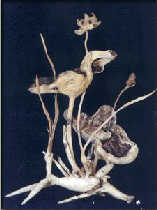
Lotus
Root carving is a traditional art in China. Integrating ingenuity and craftiness, root carving not only employs ways of expressions similar to wood carvings, sculptures and stone carvings, but also demonstrates the unique features of root carving by absorbing the techniques exhibited in the creation of other carving arts.
History
China has a long history of root carving: Primitive people began to make effigies out of wood for ornaments. In 1982, when cleaning the No 1 tomb of the Chu state excavated in Mashan, a local museum employee in Jingzhou County, Hubei Province discovered a root carving believed to have been made between 340 and 270BC in the late Warring States Period - 2,300 years ago. It featured a four-legged animal with a tiger's head, a dragon's body and a rabbit's tail; its manner was full of verve and simple and elegant in hue. By the Sui and Tang dynasties, root art was very prosperous. Records from The Biography of Li Mi present a root carving entitled "Dragon-shaped Claw" made from a crude tree root for the emperor. Root carving artwork from the Qing Dynasty (1644-1911), such as the "Phoenix" and "Jade Dragon" have been on display in Yuyuan in Shanghai until today. These works thoroughly exhibit the verves of root carving.
Since the third plenary session of the 11th Congress of the CPC, China's economy has witnessed enormous developments. Under such circumstances, the art of root carving thrived. In 1983, a documentary called The Art of Root was filmed; the "Chinese Root Art Exhibition" was held at the China National Museum of Fine Arts in 1985 and, in the same year, the Root Art Association under the Chinese Arts and Crafts Institute was established, which was regarded as laying an academic basis for Chinese root art, symbolizing its standardization. With approval from the Ministry of Civil Affairs, the Class 2 Association was promoted to the China Root Art and Fine Arts Institute -- a Class 1 association directly under the China Federation of Literary and Art Circles. In the meantime, over 40 root-art societies were developed all over the country. The number of root-art factories continues to climb in provinces such as Fujian, Zhejiang, Anhui, Jiangsu, etc, with root-art works reaching new levels. Owing to its originality and unique artistic appeal, Chinese root art is winning the hearts of more and more people.










